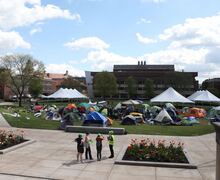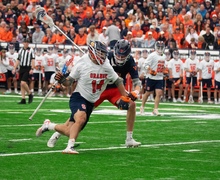Blackface makes its way to college campuses
Blackface is nothing new to the Syracuse University community.
An incident in 2002 involving a student dressed in blackface as Tiger Woods mirrors the recent incident this past Halloween, in which a State University of New York College of Environmental Science and Forestry student dressed up as a ‘Pacific Islander.’ The student covered himself in dark body makeup, wore a grass skirt and carried a wooden staff.
But blackface incidents like the ones seen on the SU campus the past few years are far from an SU-exclusive phenomenon.
Colleges across the country have seen similar incidents in which students don black face paint and are then faced with a slew of controversy afterwards.
The reason for these inevitable backlashes, however, stems from blackface’s history.
Blackface’s first incarnation was as a staple of traveling minstrel shows in the Civil War Era.
‘The origin of blackface goes back to traveling minstrel shows in the south, during the Civil War, post-Civil War period,’ said Joe Whelan, publications director for the Syracuse Stage.
At the time, white performers portrayed black characters by painting their faces and playing stereotypical roles as clumsy, clownish characters. Blackface translated easily into vaudeville shows and from there into early films, Whelan said. As the film industry developed, so did its ability to reach larger and larger audiences, and blackface was suddenly no longer a localized element but something the entire country could see.
One of the most controversial early films that utilized blackface was 1915’s ‘The Birth of a Nation,’ which sparked riots across the country due to its depictions of the Ku Klux Klan as heroes fighting an invasion of blacks in the South. The film portrays white men in blackface, raping and pillaging townspeople in the South.
In recent times, blackface has been rehashed on college campuses across the nation because of students dressing in blackface costumes. Auburn University (Ala.), Oklahoma State, Union College (N.Y.) and the University of Mississippi have all had occurrences of students dressing up in blackface and portraying negative stereotypes in the past decade.
At Auburn, several white members of two fraternities dressed up as KKK Klansmen and black gang members. An Oklahoma State party went even further when students dressed as Klansmen and pretended to lynch students in blackface. At the University of Mississippi, pictures emerged from a party showing a student in a police costume holding a gun to the head of a student in blackface who was pretending to pick cotton
‘It’s a mockery of a group of people as a race,’ said Monica Roberts, co-chairwomen of the Team Against Bias. ‘It has a historical context that emerged out of slavery and was used to keep black people in their place.’
Syracuse’s own history with blackface dates to the 2002 incident when a student dressed as Tiger Woods, complete with black face paint.
The student, then-senior Aaron Levine, was seen walking around the campus area by many groups of people, said Marlene Hall, director of the Department of Public Safety. When a call was placed to Public Safety, Hall said, the dispatcher was at first confused by the call because she did not know what blackface was.
‘There wasn’t a consistent knowledge of what blackface was when I started here,’ said Hall, who was in her first year at SU when the Levine incident occurred. ‘I’d say that there was a 50/50 split between people who were aware of it and people who weren’t.’
The Levine incident evoked a lot reaction from the student body, Hall said. But thanks to the amount of interaction between administration and students, a potentially dangerous situation was averted.
‘When you’re dealing with something so emotionally charged, with that many people, it presents many problems,’ she said.
After the incident, Public Safety moved to improve their ability to react to such situations, Hall said.
‘Basic diversity’ training was replaced by a more intensive, 15-hour online program that has been completed by nearly all of Public Safety’s full-time staff. The way in which bias-related incidents are treated also changed after the 2002 incident.
‘The federal government makes schools publicly report all hate crimes,’ Hall said, ‘But the SU community was concerned and felt more than hate crimes should be shown.’
As a result, SU began reporting bias-related incidents as well, documenting occurrences based on location of the incident and the nature of the bias, Hall said.
With all these lessons learned, SU’s response to this Halloween’s blackface incident was more focused than the reaction to the previous incident, Hall said. She noted that her department’s perspective was much improved, and that history had taught it valuable lessons.
‘I still learned new things from both of these incidents, and I considered myself a knowledgeable person,’ Hall said.
For students, history’s lessons are far more transient, as class after class moves through the university.
‘With issues like this, that hit campuses hard, we are always having to re-educate,’ she said. ‘Each freshman class, you have to start over. For the people who are hit hardest by these incidents, it can be frustrating. And ‘frustrating’ is a minor descriptor.’
Published on November 13, 2003 at 12:00 pm




